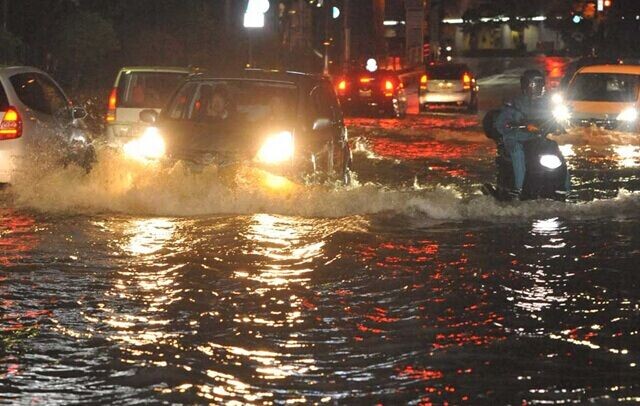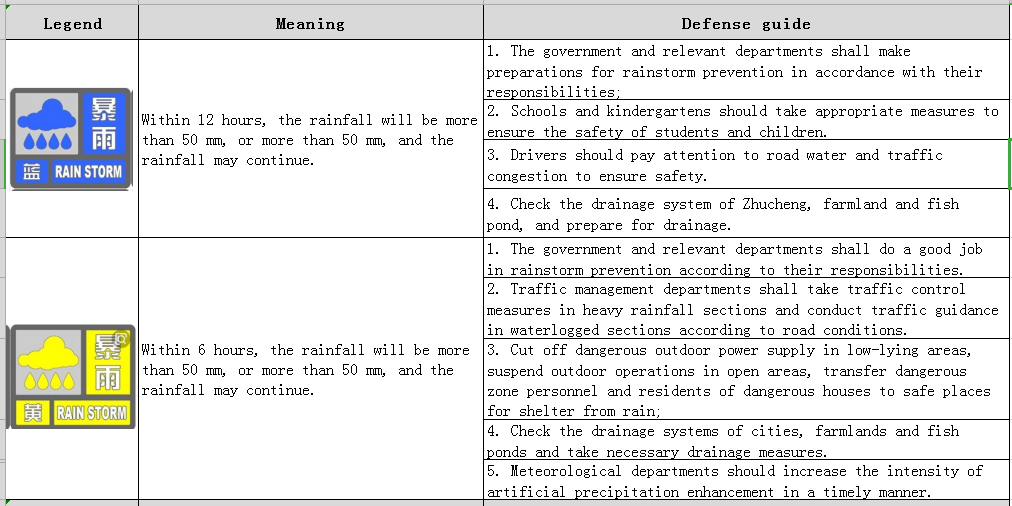Flood disaster in China is a meteorological disaster second only to drought disaster with the characteristics of wide range, frequent occurrence, strong sudden occurrence and great loss.Flood disasters are related to the spatial and temporal distribution of precipitation and topography, which mainly occur from April to September in China, with more in the East and less in the west;more coastal areas and less inland areas;more plain areas, less plateau and mountainous areas.
Summary of rainstorm
Rainstorms are heavy rains, which refer to the precipitation of more than 16 mm per hour generally,or more than 30 mm for 12 consecutive hours, or more than 50 mm for 24 consecutive hours.According to the meteorological regulations in China, the precipitation of 50 mm or more in 24 hours is called “rainstorm”.According to the intensity of precipitation, it can be divided into three levels: the 24-hour precipitation of 50〜99.9 mm is called “rainstorm”; the rainfall below 100〜200 mm is “heavy rainstorm”; and the rainstorm above 200 mm is “extremely heavy rainstorm”. Due to the different precipitation and topographic characteristics, the standards of rainstorms and floods are also different.
(1)The formation of rainstorm. The process of rainstorm formation is quite complicated, generally speaking, the main physical conditions of rainstorm are sufficient and continuous water vapor, strong and lasting upwelling motion of airflow and instability of atmospheric structure.The favorable combination of large, medium and small scale weather systems and underlying surface, especially terrain, can produce larger rainstorms.The main weather systems causing heavy rain in China are fronts, cyclones, shear lines, low eddies, troughs, typhoons, easterly waves and tropical convergence zones.In addition, thermal thunderstorms in arid and semi-arid areas can also cause short-duration, small-area heavy rainstorms.Its formation and intensity are closely related to six conditions: abundant water vapor distribution and supply; rising motion of the atmosphere; stratification stability and mesoscale instability; vertical wind shear; cloud microphysical process; topography.
(2) Seasonal geographical distribution.China is a country with heavy rains, except for some provinces and regions in Northwest China, there are almost all heavy rains.Winter rainstorms are confined to the coastal areas of South China, rainstorms frequently occur in South China in April-June.From June to July, the middle and lower reaches of the Yangtze River often experienced persistent rainstorms, which lasted for a long time, covered a wide area and had a large amount of rainstorms.July-August is the main rainstorm season in the northern provinces with heavy rainfall intensity. The rain belt gradually retreated southward from August to October. After summer and autumn, typhoon rains in the East and South China Seas are very active, and typhoon raindrops are often very large.There are two main areas where rainstorms are concentrated: one is the Liaodong Peninsula, the Shandong Peninsula and the southeastern coast; the other is the Daxing'an Mountains, the Taihang Mountains and the eastern foot of Wuyi Mountains.In addition, the southern foot of Yinshan, Qinling and Nanling mountains are also the areas where rainstorms occur frequently.The regional distribution of rainstorm days is more obvious in the South than in the north; more coastal areas and less inland areas;more windward slopes and fewer leeward slopes.
The impact of rainstorm
Rainstorm is a kind of disastrous weather with serious impact.Continuous rainstorms, heavy rainstorms and extraordinary rainstorms in a certain area often lead to mountain torrents, dam collapse of reservoirs, overflow of rivers, collapse of houses, flooding of farmland, interruption of transportation and telecommunications, which will bring serious harm to the national economy and people's lives and property.Heavy rains, especially large-scale continuous rainstorms and concentrated heavy rainstorms, not only affect industrial and agricultural production, but also may endanger people's lives and cause serious economic losses. Especially in some low-lying and terrain-blocked areas, rainwater can not be quickly released, resulting in excessive saturation of farmland water and soil moisture, which will cause more disasters.
Two main hazards of rainstorm:
(1) Damage of waterlogging.Due to the rapid and heavy rainstorm, poor drainage is easy to cause water accumulation and waterlogging, soil pore is filled with water, resulting in the lack of oxygen in the root system of terrestrial plants, which inhibits root physiological activities, strengthens the anaerobic process, produces toxic substances, and reduces crop yield.
(2)Flood disaster.Floods caused by rainstorms inundate crops, which make it difficult for the metabolism of crops to proceed normally and cause various kinds of damage. The deeper the flooding is, the longer the flooding time is, the more serious the damage is. The mountain torrents and river floods caused by heavy rainstorms not only endanger crops, fruit trees, forestry and fisheries, but also destroy farmhouses and industrial and agricultural facilities, even cause casualties and serious economic losses.
Torrential rains are harmful to human beings and beneficial to human beings, in many cases, the advantages of moderate rainstorms outweigh the disadvantages.After a long drought, a heavy rain will relieve the drought.During the summer drought in southern China, people often look forward to the arrival of tropical cyclones, because the rainstorms it brings can relieve the drought.In many parts of northern China, the annual precipitation is determined by one or two rainstorms, and there is no drought in rainstorms.In today's increasingly tense water use in many cities, people concerned are eager to fill the reservoir with rainstorms.

The prevention of rainstorm
(1) Classification of rainstorm warning signals
Rainstorm warning signals are divided into four levels, which are blue, yellow, orange and red (Table 6-3).


(2) Preventive measures
①Prepare for the rainstorm.Check houses, if they are dilapidated houses or in low-lying areas, should be transferred in time;outdoor activities will be suspended, and schools may suspend classes;check the safety of electric circuit, furnace and other facilities, turn off the main switch of power supply;clean up the items covered in the open air in advance, and put the valuables in the house at a high place.Close the cover in advance and dry the goods in the open air;suspend field work, outdoor personnel should immediately go to a high - lying places or caves shelter.
②Clear responsibility, each does his duty.Marine and fishery departments should do a good job of returning fishing vessels to port, and urge those vessels that have not yet returned to port to return to port quickly or to take shelter in nearby ports.Tourism departments should immediately stop organizing marine tourism projects to prevent dangerous situations.Port enterprises should reinforce loading and unloading equipment and facilities in advance and make good reserves of flood control and flood fighting materials. Public security and transportation departments should strengthen the management of key sections, timely guide traffic and ensure traffic safety.Education departments and all types of industrial and mining enterprises should implement safety measures against wind, snow and freezing in advance to ensure the personal safety of students and workers of industrial and mining enterprises.Government departments at all levels should adhere to 24-hour duty and implement the leadership system.Meteorological departments should pay close attention to weather changes and provide timely warning information on preventing storm surges at sea.
Comment list ( 0 )
